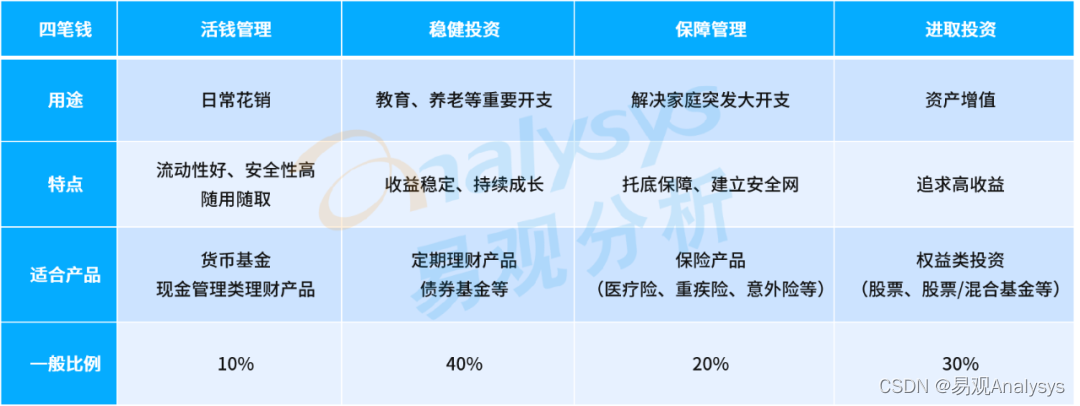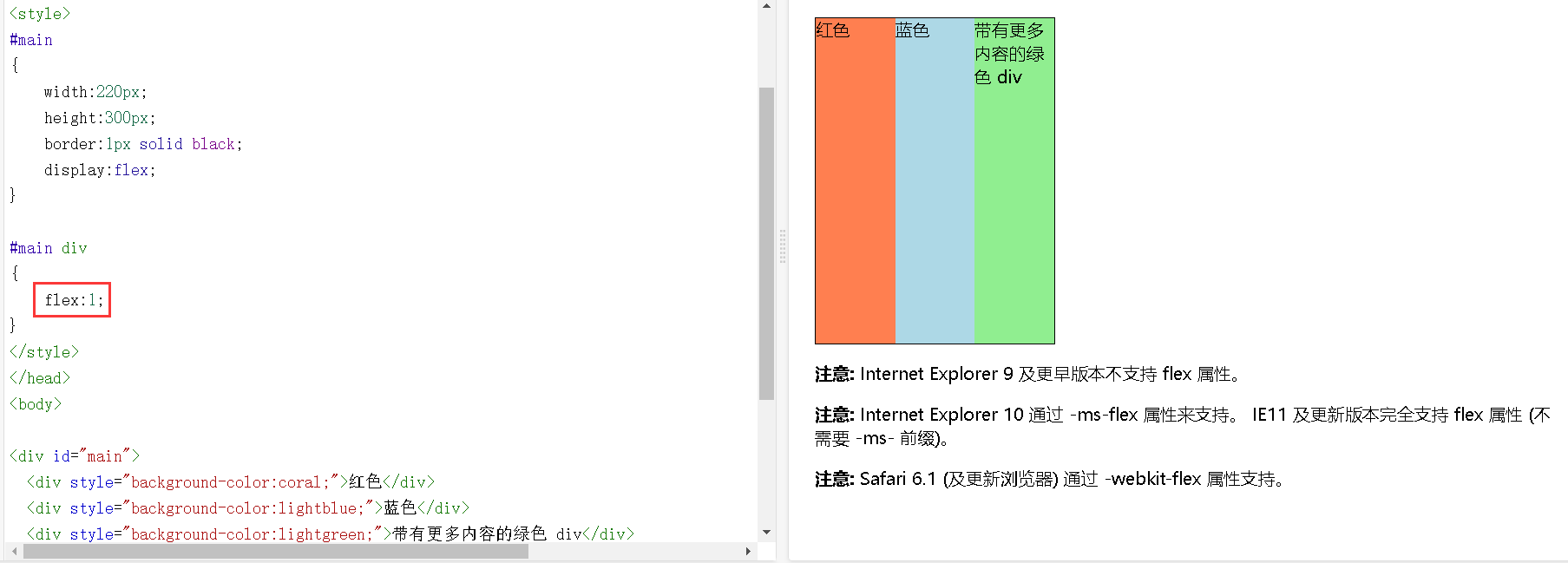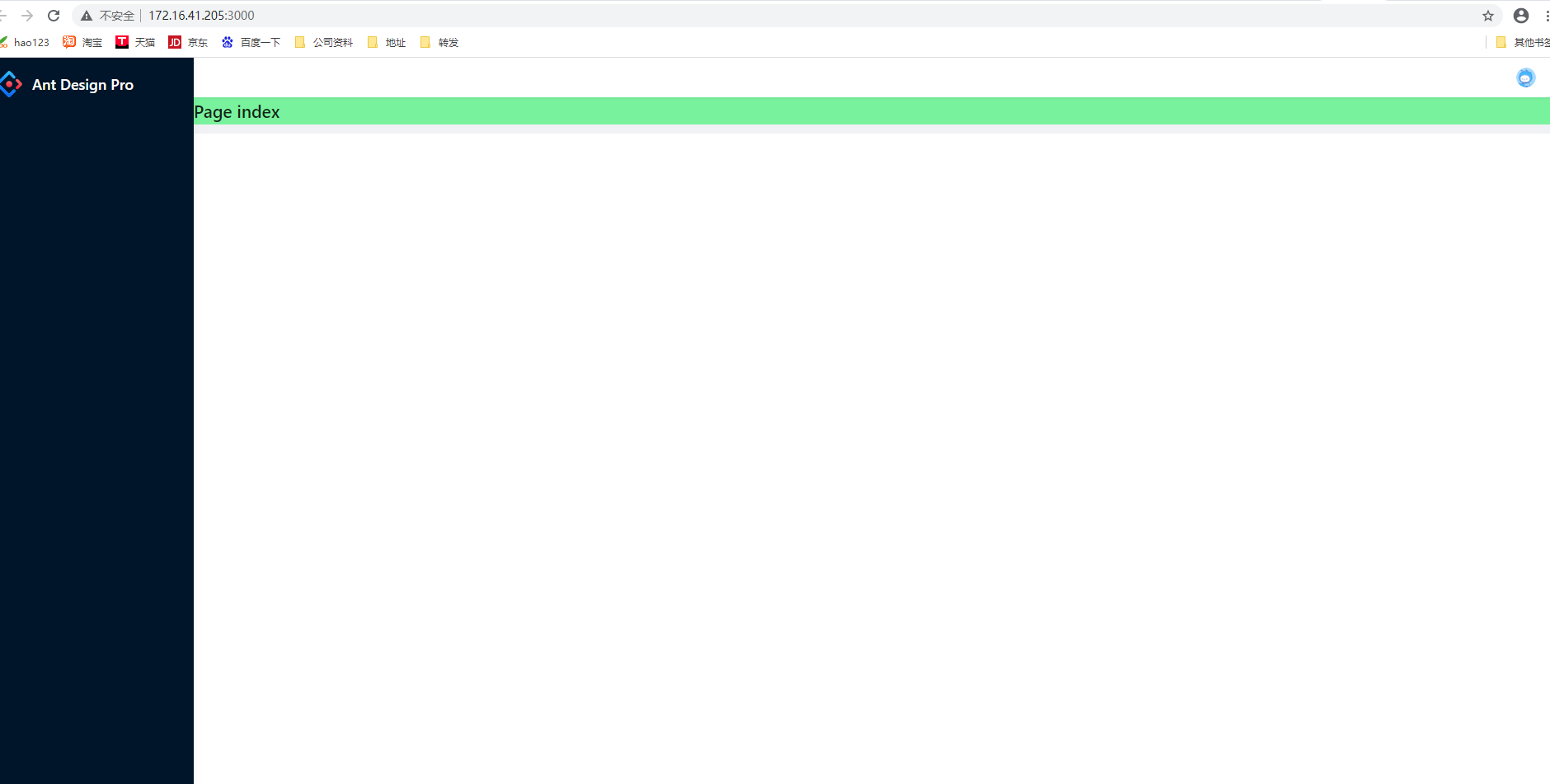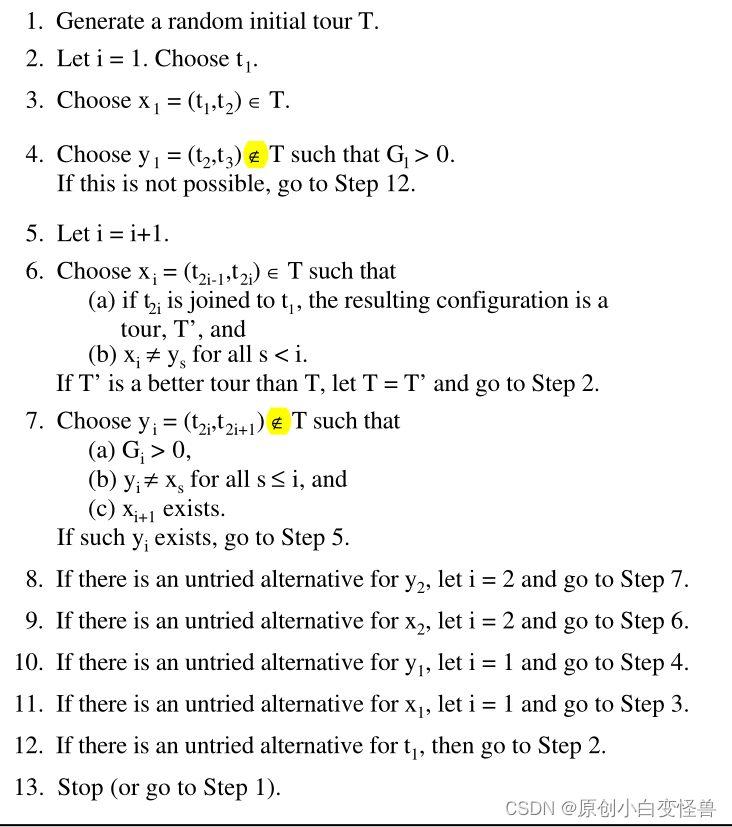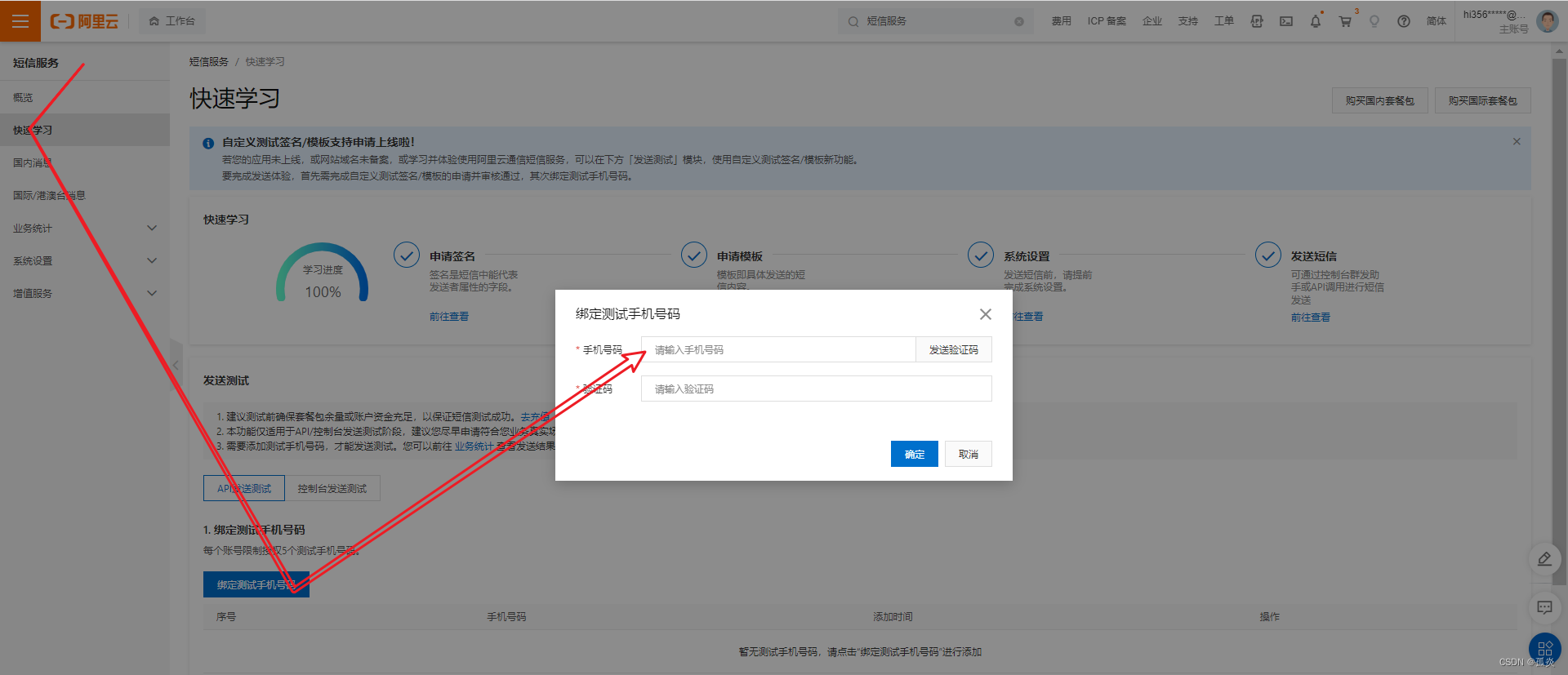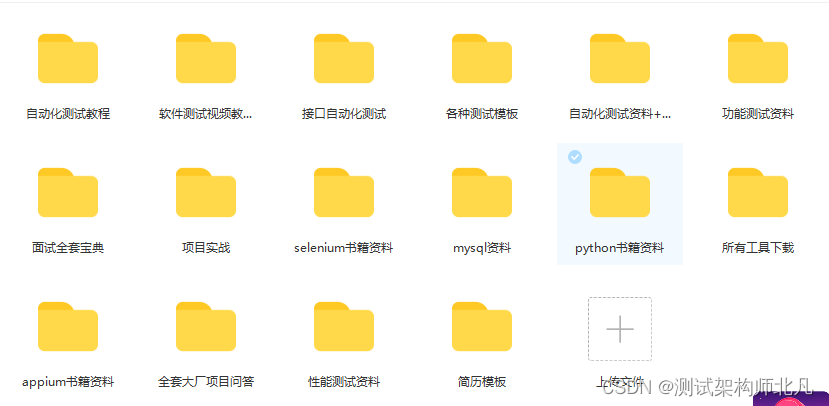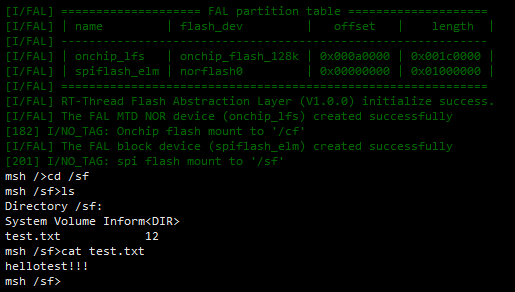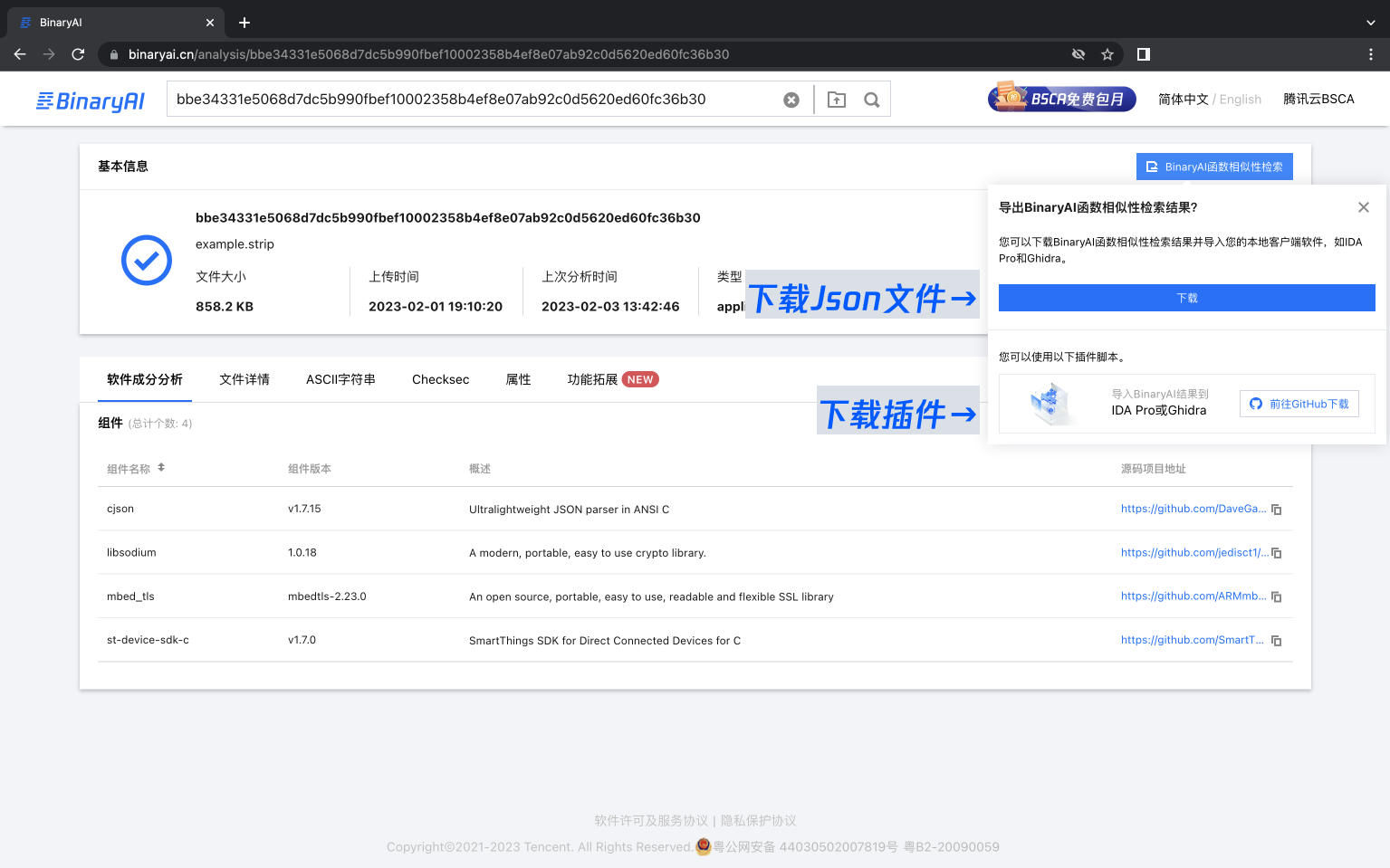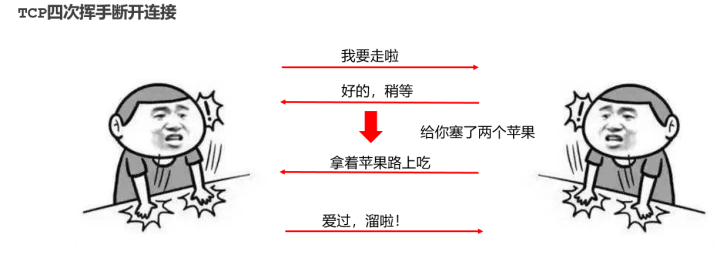shiro、springboot、vue、elementUI CDN模式前后端分离的权限管理demo 附源码
源码下载地址
https://github.com/Aizhuxueliang/springboot_shiro.git
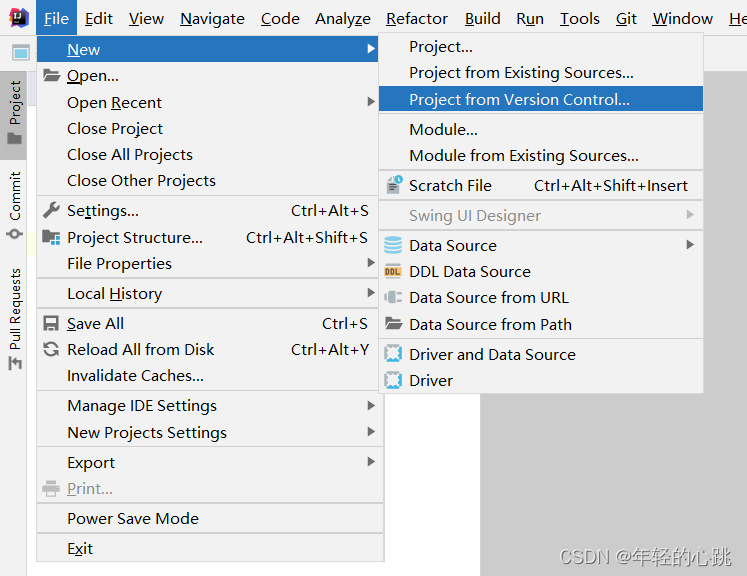
前提你电脑的安装好这些工具:jdk8、idea、maven、git、mysql;
shiro的主要概念
- Shiro是一个强大的简单易用的Java安全框架,主要用来更便捷的认证、授权、加密、会话管理、与Web集成、缓存等;
- Shiro使用起来小而简单;
- spring中有spring security ,是一个权限框架,它和spring依赖过于紧密,没有shiro使用简单;
- shiro不依赖于spring,shiro不仅可以实现web应用的权限管理,还可以实现c/s系统,分布式系统权限管理;
在应用程序角度来观察如何使用Shiro完成工作

Subject:主体,代表了当前“用户”,这个用户不一定是一个具体的人,与当前应用交互的任何东西都是Subject,如网络爬虫,机器人等;即一个抽象概念;所有Subject 都绑定到SecurityManager,与Subject的所有交互都会委托给SecurityManager;可以把Subject认为是一个门面;SecurityManager才是实际的执行者;
SecurityManager:安全管理器;即所有与安全有关的操作都会与SecurityManager 交互;且它管理着所有Subject;可以看出它是Shiro 的核心,它负责与后边介绍的其他组件进行交互,如果学习过SpringMVC,你可以把它看成DispatcherServlet前端控制器;
Realm:域,Shiro从从Realm获取安全数据(如用户、角色、权限),就是说SecurityManager要验证用户身份,那么它需要从Realm获取相应的用户进行比较以确定用户身份是否合法;也需要从Realm得到用户相应的角色/权限进行验证用户是否能进行操作;可以把Realm看成DataSource,即安全数据源。
shiro官方文档
https://shiro.apache.org/architecture.html
前端CDN的方式使用elementUI、vue、vue-router、axios画页面
CDN(内容分发网络)本身是指一种请求资源的方式。说白了就是在本地,通过script头去请求对应的脚本资源的一种方式。我在这里要说的就是直接引用 (demo是直接引用的,注意电脑联网)或者下载Vue.js和elementUI.js放在本地,进行项目开发的方式。而不是通过npm包管理工具去下载vue包。
cdn方式引入elementui 官方API:https://element.eleme.cn/#/zh-CN/component/installation
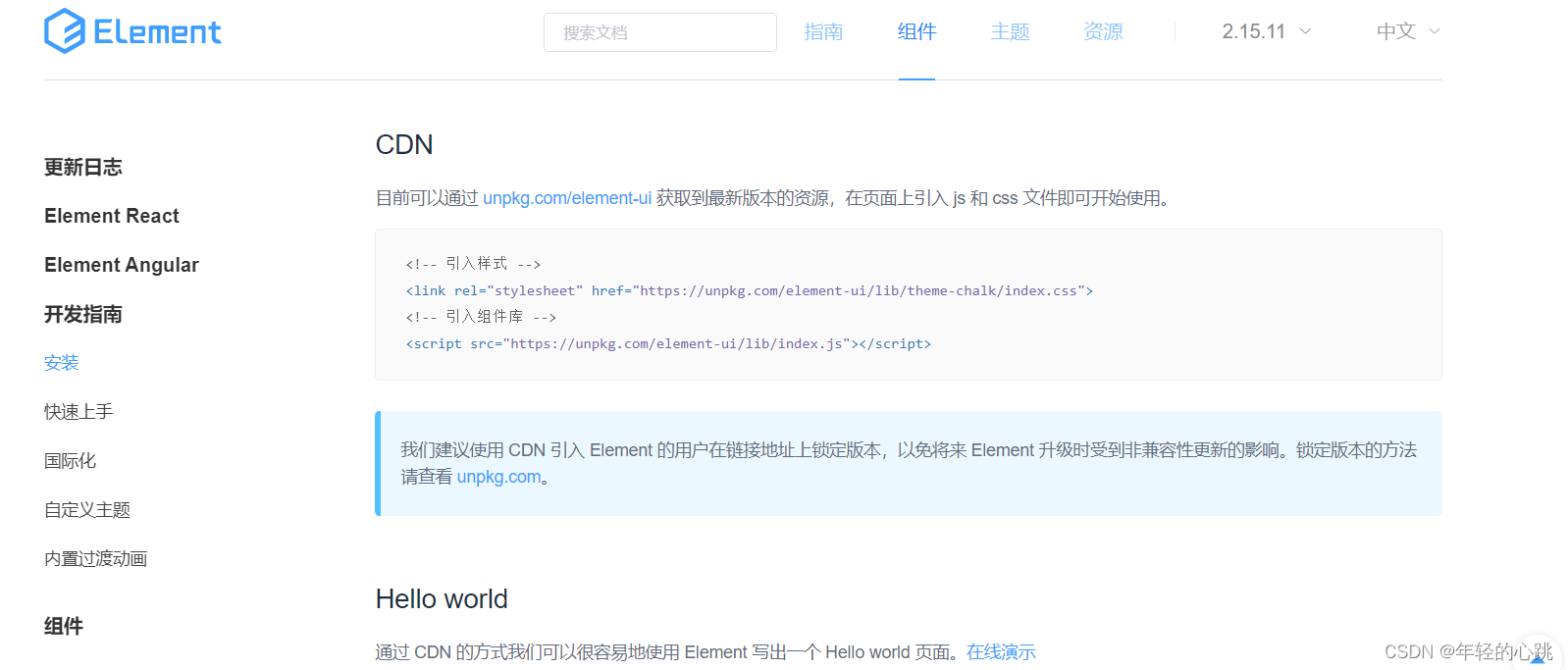
cdn方式引入vue-router官方API:https://router.vuejs.org/zh/guide/#html

DEMO的整体流程设计
技术层面了解完就该设计业务流程了,如图:
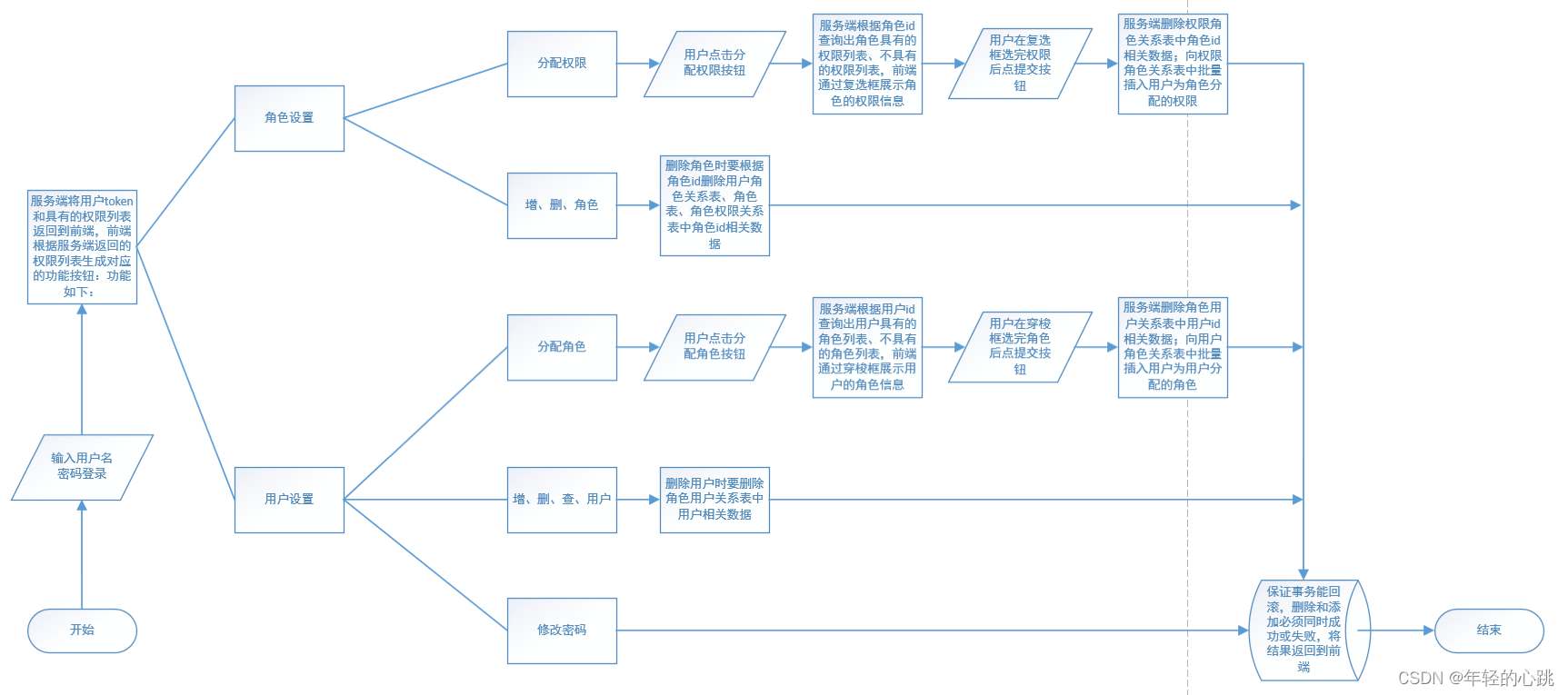
demo整体结构
如图:

主要功能页面
1、登录

2、用户查询

3、分配角色
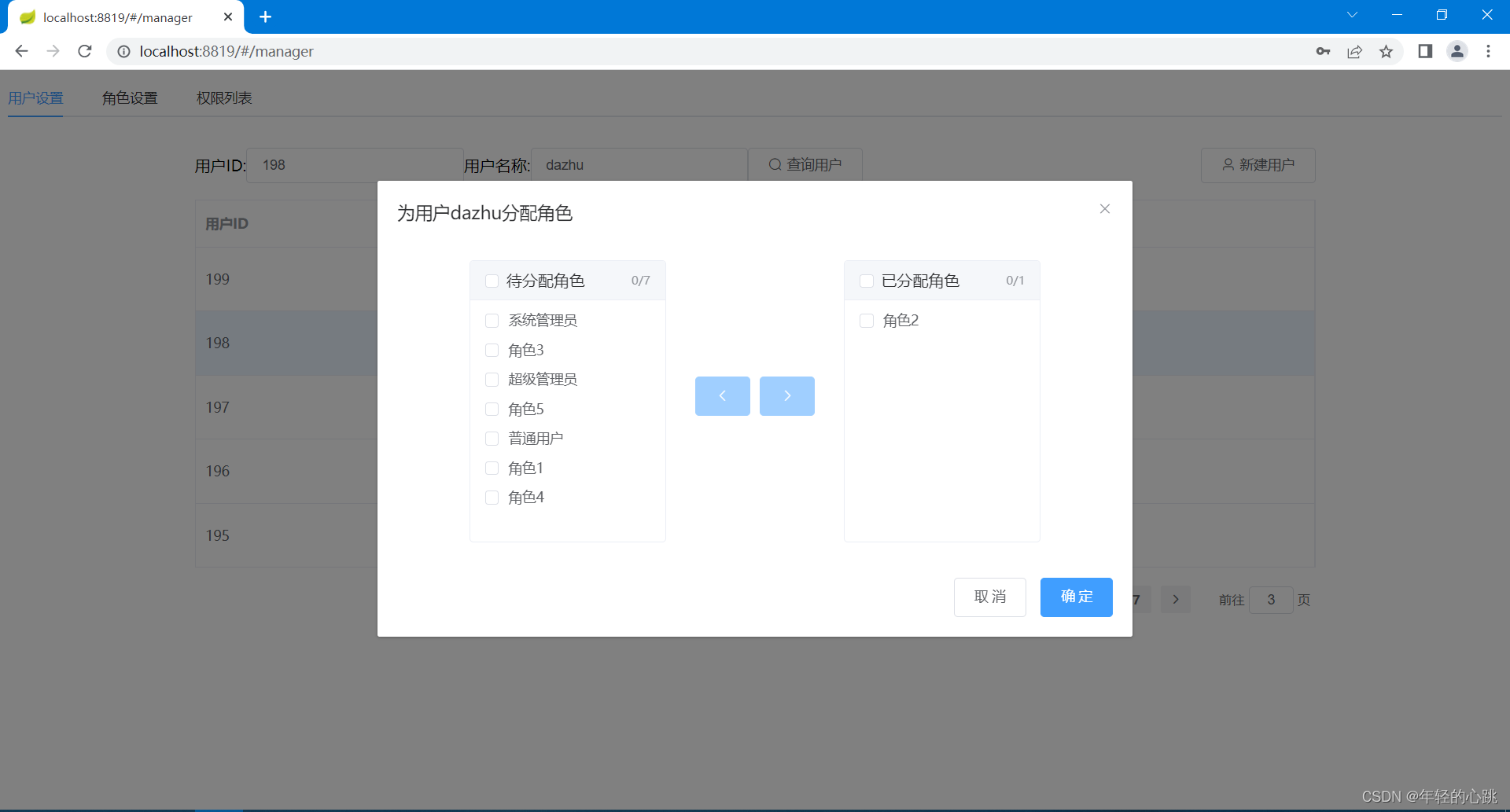
4、删除角色
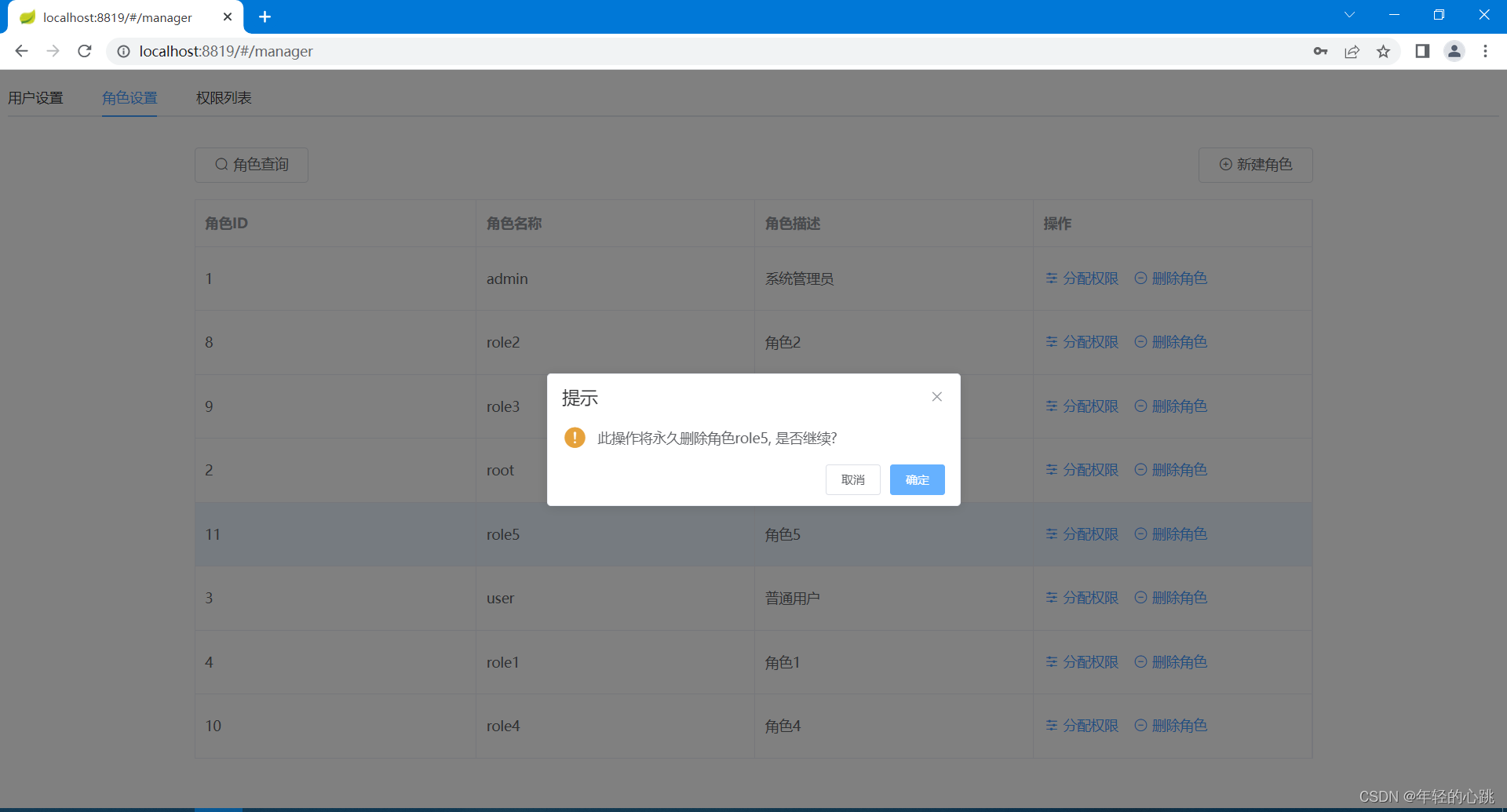
5、新建用户

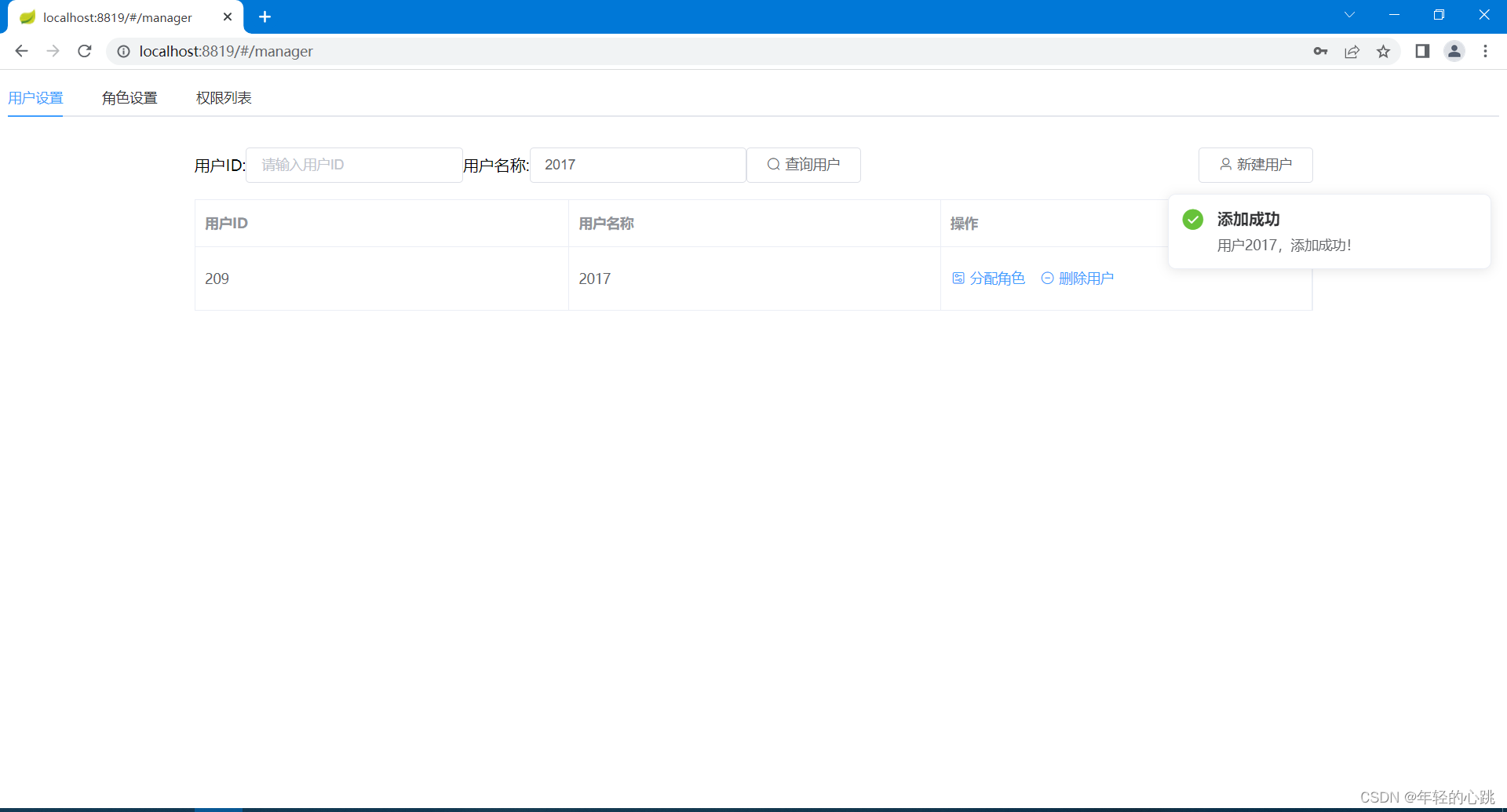
6、分配权限
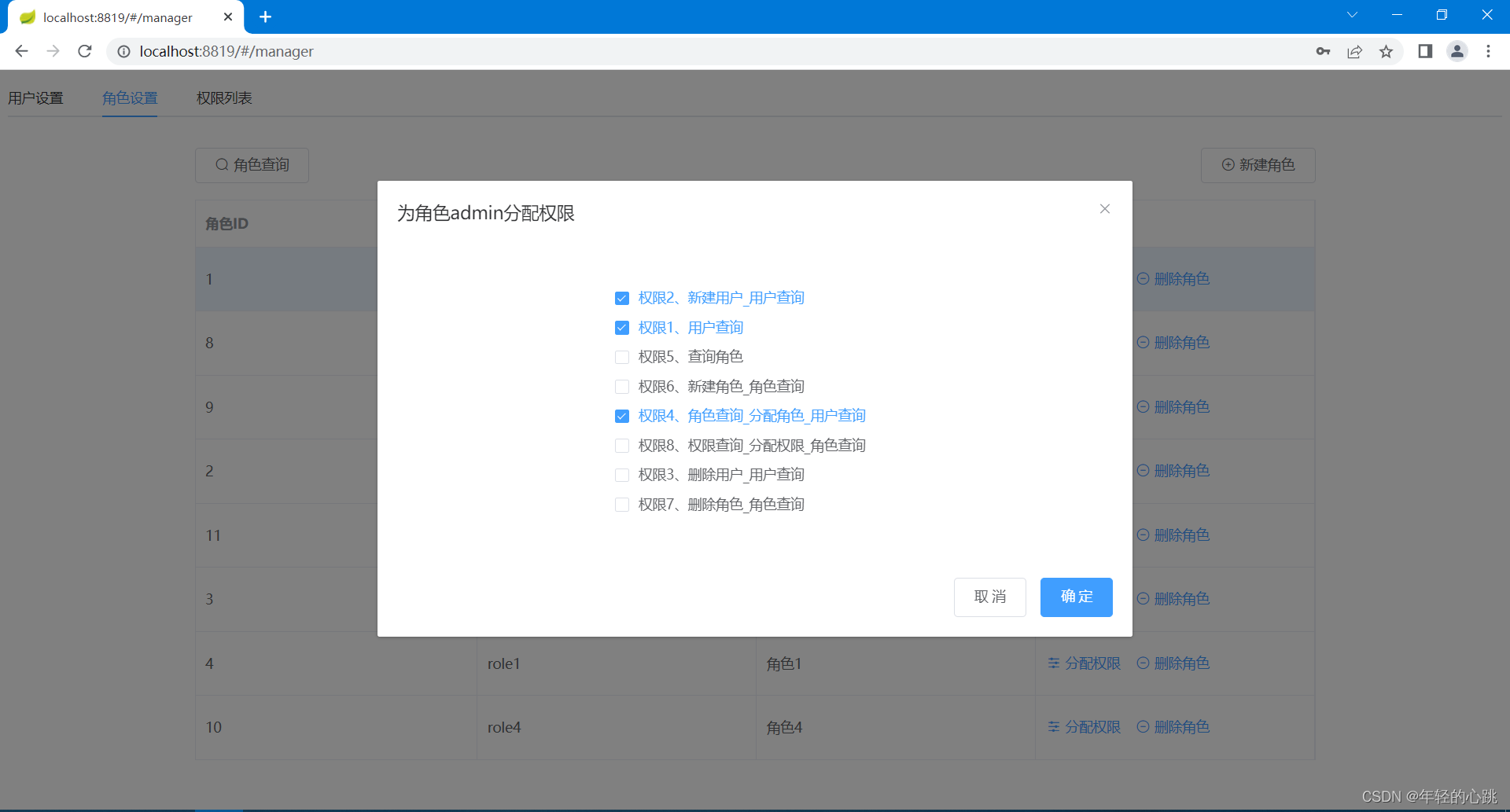
7、新建角色
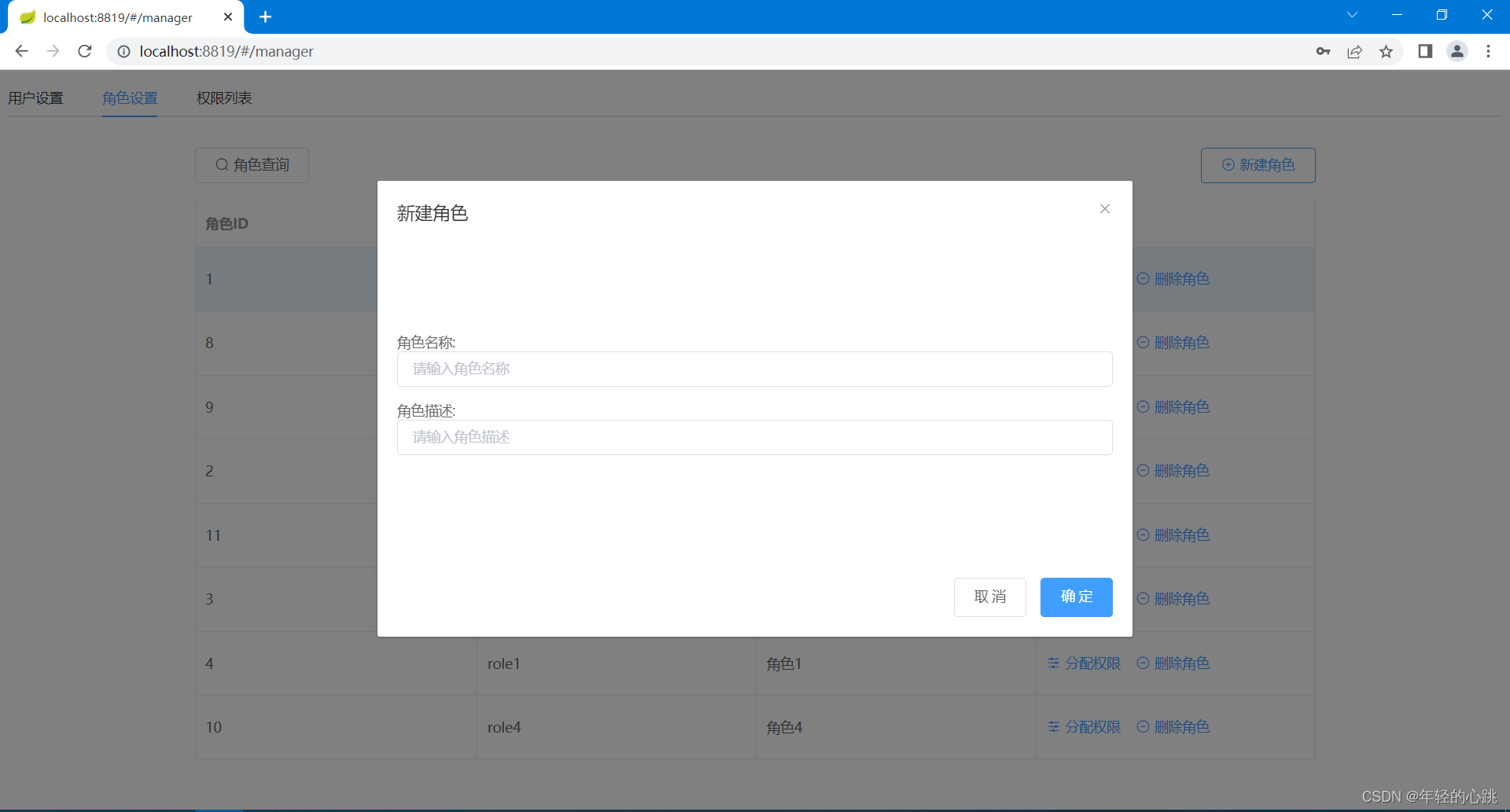
主要代码
com/example/demo/controller/UserCtrl.java
package com.example.demo.controller;
import com.example.demo.entity.Role;
import com.example.demo.entity.User;
import com.example.demo.service.UserService;
import org.apache.shiro.SecurityUtils;
import org.apache.shiro.authc.UsernamePasswordToken;
import org.apache.shiro.subject.Subject;
import org.springframework.beans.factory.annotation.Autowired;
import org.springframework.web.bind.annotation.*;
import java.util.Map;
/**
* 控制层
*/
@RestController
@RequestMapping("/user")
public class UserCtrl {
@Autowired
private UserService userService;
/**
* 登录接口
*
* @param user user
* @return resultMap
*/
@RequestMapping(value = "/login", method = RequestMethod.POST)
public Map<String, Object> login(@RequestBody User user) {
//拿到主体
Subject subject = SecurityUtils.getSubject();
try {
UsernamePasswordToken usernamePasswordToken = new UsernamePasswordToken(user.getUsername(), user.getPassword());
subject.login(usernamePasswordToken);
Object permissions = subject.getSession().getAttribute("permissions");
subject.getSession().removeAttribute("permissions");
return userService.resultMap("permissions", permissions, "token", subject.getSession().getId(), "", "");
}catch (Exception e){
e.printStackTrace();
return userService.resultMap("error", e.getMessage(), "", "", "", "");
}
}
/**
* 获取用户的角色类型
*
* @param user user
* @return resultMap
*/
@RequestMapping(value = "/findRoleListByUserId", method = RequestMethod.POST)
public Map<String, Object> findRoleListByUserId(@RequestBody User user) {
try{
return userService.findRoleListByUserId(user.getId());
}catch (Exception e){
e.printStackTrace();
return userService.resultMap("error", e.getMessage(), "", "", "", "");
}
}
/**
* 获取角色的权限类型
*
* @param role role
* @return resultMap
*/
@RequestMapping(value = "/findPermissionListByRoleId", method = RequestMethod.POST)
public Map<String, Object> findPermissionListByRoleId(@RequestBody Role role) {
try{
return userService.findPermissionListByRoleId(role.getId());
}catch (Exception e){
e.printStackTrace();
return userService.resultMap("error", e.getMessage(), "", "", "", "");
}
}
/**
* 更新角色具有的权限
*
* @param role role
* @return resultMap
*/
@RequestMapping(value = "/updateRolePermission", method = RequestMethod.POST)
public Map<String, Object> updateRolePermission(@RequestBody Role role) {
try{
return userService.updateRolePermission(role);
}catch (Exception e){
e.printStackTrace();
return userService.resultMap("error", e.getMessage(), "", "", "", "");
}
}
/**
* 删除角色
*
* @param role role
* @return resultMap
*/
@RequestMapping(value = "/removeRole", method = RequestMethod.POST)
public Map<String, Object> removeRole(@RequestBody Role role) {
try{
return userService.removeRole(role);
}catch (Exception e){
e.printStackTrace();
return userService.resultMap("error", e.getMessage(), "", "", "", "");
}
}
/**
* 添加角色
*
* @param role role
* @return resultMap
*/
@RequestMapping(value = "/addRole", method = RequestMethod.POST)
public Map<String, Object> addRole(@RequestBody Role role) {
try{
return userService.addRole(role);
}catch (Exception e){
e.printStackTrace();
return userService.resultMap("error", e.getMessage(), "", "", "", "");
}
}
/**
* 更新用户具有的角色
*
* @param user user
* @return resultMap
*/
@RequestMapping(value = "/updateUserRole", method = RequestMethod.POST)
public Map<String, Object> updateUserRole(@RequestBody User user) {
try{
return userService.updateUserRole(user);
}catch (Exception e){
e.printStackTrace();
return userService.resultMap("error", e.getMessage(), "", "", "", "");
}
}
/**
* 根据用户提供的条件分页查询用户
*
* @param user user
* @return resultMap
*/
@RequestMapping(value = "/queryUserListPage", method = RequestMethod.POST)
public Map<String, Object> queryUserListPage(@RequestBody User user) {
try{
return userService.queryUserListPage(user);
}catch (Exception e){
e.printStackTrace();
return userService.resultMap("error", e.getMessage(), "", "", "", "");
}
}
/**
* 删除用户
*
* @param user user
* @return resultMap
*/
@RequestMapping(value = "/removeUser", method = RequestMethod.POST)
public Map<String, Object> removeUser(@RequestBody User user) {
try{
return userService.removeUser(user);
}catch (Exception e){
e.printStackTrace();
return userService.resultMap("error", e.getMessage(), "", "", "", "");
}
}
/**
* 新增用户
*
* @param user user
* @return resultMap
*/
@RequestMapping(value = "/insertUser", method = RequestMethod.POST)
public Map<String, Object> insertUser(@RequestBody User user) {
try{
return userService.insertUser(user);
}catch (Exception e){
e.printStackTrace();
return userService.resultMap("error", e.getMessage(), "", "", "", "");
}
}
}
com/example/demo/service/UserService.java
package com.example.demo.service;
import com.example.demo.entity.Permission;
import com.example.demo.entity.Role;
import com.example.demo.entity.User;
import com.example.demo.mapper.PermissionMapper;
import com.example.demo.mapper.UserMapper;
import com.example.demo.mapper.RoleMapper;
import org.apache.commons.collections.CollectionUtils;
import org.springframework.beans.factory.annotation.Autowired;
import org.springframework.stereotype.Service;
import org.springframework.transaction.annotation.Transactional;
import java.util.*;
import java.util.stream.Collectors;
/**
* 服务层
*/
@Service
public class UserService {
@Autowired
private UserMapper userMapper;
@Autowired
private RoleMapper roleMapper;
@Autowired
private PermissionMapper permissionMapper;
public User findUserByName(String userName) {
User user = userMapper.findUserByName(userName);
//用户角色的集合
List<Role> roleList = roleMapper.findRoleListByUserId(user.getId());
user.setRoleList(roleList);
return user;
}
public Map<String, Object> findRoleListByUserId(int userId){
//用戶具有的角色集合
List<Role> beRoleList = roleMapper.findRoleListByUserIdNotPermission(userId);
//用戶没有的角色集合
List<Role> notRoleList = roleMapper.findNotRoleListByUserIdNotPermission(userId);
//所有角色集合
Collection<?> allRoleList = CollectionUtils.union(beRoleList, notRoleList);
return this.resultMap("beRoleList", beRoleList, "notRoleList", notRoleList, "allRoleList", allRoleList);
}
@Transactional(rollbackFor = {Exception.class})
public Map<String, Object> updateUserRole(User user){
int removeUserRole = userMapper.removeUserRoleByUserId(user.getId());
int addUserRole = 0;
if (user.getRoleList().size()!=0 && user.getRoleList()!=null){
addUserRole = userMapper.addUserRole(user);
}
return this.resultMap("removeUserRole", removeUserRole, "addUserRole", addUserRole, "", "");
}
public Map<String, Object> findPermissionListByRoleId(int roleId){
//角色具有的权限集合
List<Permission> bePermissionList = permissionMapper.findByPermissionListByRoleId(roleId);
//角色没有的权限集合
List<Permission> notPermissionList = permissionMapper.findNotPermissionListByRoleId(roleId);
//所有权限集合
Collection<?> allPermissionList = CollectionUtils.union(bePermissionList, notPermissionList);
return this.resultMap("bePermissionList", bePermissionList, "notPermissionList", notPermissionList, "allPermissionList", allPermissionList);
}
@Transactional(rollbackFor = {Exception.class})
public Map<String, Object> updateRolePermission(Role role){
int removeRolePermission = roleMapper.removeRolePermissionByRoleId(role.getId());
int addRolePermission = 0;
if (role.getPermissionList().size()!=0 && role.getPermissionList()!=null){
addRolePermission = roleMapper.addRolePermission(role);
}
return this.resultMap("removeRolePermission", removeRolePermission, "addRolePermission", addRolePermission, "", "");
}
@Transactional(rollbackFor = {Exception.class})
public Map<String, Object> removeRole(Role role){
int removeRolePermission = roleMapper.removeRolePermissionByRoleId(role.getId());
int removeRole = roleMapper.removeRoleByRoleId(role.getId());
int removeUserRole = userMapper.removeUserRoleByRoleId(role.getId());
return this.resultMap("removeRolePermission", removeRolePermission, "removeRole", removeRole, "removeUserRole", removeUserRole);
}
public Map<String, Object> queryUserListPage(User user){
//当前页页码
int pageNow = user.getReserve1() < 1 ? 1 : user.getReserve1();
//当前页第一行索引
user.setReserve1(5*(pageNow - 1));
List<User> userListPage = userMapper.queryUserListPage(user);
int userRowCount = userMapper.getUserRowCount(user);
return this.resultMap("userListPage", userListPage, "userRowCount", userRowCount, "", "");
}
public Map<String, Object> addRole(Role role){
int addRole = roleMapper.addRole(role);
return this.resultMap("addRole", addRole, "", "", "", "");
}
@Transactional(rollbackFor = {Exception.class})
public Map<String, Object> removeUser(User user){
int removeUser = userMapper.removeUserByUserId(user.getId());
int removeUserRole = userMapper.removeUserRoleByUserId(user.getId());
return this.resultMap("removeUser", removeUser, "removeUserRole", removeUserRole, "", "");
}
public Map<String, Object> insertUser(User user) {
int addUser = userMapper.insertUser(user);
return this.resultMap("addUser", addUser, "", "", "", "");
}
public Map<String, Object> resultMap(String str1, Object obj1, String str2, Object obj2, String str3, Object obj3){
Map<String, Object> resultMap = new HashMap<>();
if (!"".equals(str1) || !"".equals(obj1))
resultMap.put(str1, obj1);
if (!"".equals(str2) || !"".equals(obj2))
resultMap.put(str2, obj2);
if (!"".equals(str3) || !"".equals(obj3))
resultMap.put(str3, obj3);
return resultMap;
}
}
CDN模式下的vue、vue-router、template模板挂载操作
参考:src/main/resources/static/index.html
<!DOCTYPE html>
<html>
<head>
<meta charset="UTF-8">
<!-- import CSS -->
<link rel="stylesheet" href="https://unpkg.com/element-ui/lib/theme-chalk/index.css">
</head>
<body>
<div id="app">
<router-view></router-view>
</div>
<template id="sign">
<div class="handle">
<div class="handle-input">
<div class="high70">
<span>用户名称:</span>
<el-input
v-model="username"
placeholder="请输入用户名称"
clearable></el-input>
</div>
<div class="high70">
<span>密码:</span>
<el-input
v-model="password"
placeholder="请输入密码"
clearable
show-password></el-input>
</div>
<el-button @click="login" plain>登录</el-button>
</div>
</div>
</template>
<template id="manager">
<el-tabs :tab-position="tabPosition">
<el-tab-pane label="用户设置" v-if="permissionsFlag.query_user || permissionsFlag.add_user || permissionsFlag.allot_roles || permissionsFlag.remove_user">
<el-row type="flex" justify="center">
<el-col :span="18">
<div class="handle-area">
<div class="demo-input" v-show="permissionsFlag.query_user || permissionsFlag.add_user || permissionsFlag.allot_roles || permissionsFlag.remove_user">
<span>用户ID:</span>
<el-input
v-model="id"
placeholder="请输入用户ID"
type="number"
size="medium"
clearable></el-input>
<span>用户名称:</span>
<el-input
v-model="username"
placeholder="请输入用户名称"
size="medium"
clearable></el-input>
<el-button
:plain="true"
@click="queryUserList"
icon="el-icon-search"
size="medium">查询用户</el-button>
</div>
<el-button
v-show="permissionsFlag.add_user"
:plain="true"
@click="handleAddUser"
icon="el-icon-user"
size="medium">新建用户</el-button>
</div>
<el-table
:data="tableData"
border
highlight-current-row>
<el-table-column
prop="id"
label="用户ID">
</el-table-column>
<el-table-column
prop="username"
label="用户名称">
</el-table-column>
<el-table-column
label="操作">
<template slot-scope="scope">
<el-button
v-show="permissionsFlag.allot_roles"
type="text"
icon="el-icon-set-up"
@click="handleEditUser(scope.$index, scope.row)">分配角色
</el-button>
<el-button
v-show="permissionsFlag.remove_user"
type="text"
icon="el-icon-remove-outline"
@click="handleDeleteUser(scope.$index, scope.row)">删除用户
</el-button>
</template>
</el-table-column>
</el-table>
<el-pagination
layout="total, prev, pager, next, jumper"
:total="userRowCount"
:page-size="5"
:current-page.sync="currentPage"
@current-change="queryUserListPage"
:hide-on-single-page="hidePageFlag"
background>
</el-pagination>
</el-col>
</el-row>
<el-dialog :title="roleTitle" :visible.sync="dialogEditUser" :before-close="handleClose">
<el-transfer
v-model="transferValue"
:data="transferData"
:titles="['待分配角色', '已分配角色']">
</el-transfer>
<span slot="footer" class="dialog-footer">
<el-button @click="handleClose">取 消</el-button>
<el-button type="primary" @click="assignRoles">确 定</el-button>
</span>
</el-dialog>
<el-dialog title="新建用户" :visible.sync="dialogAddUser" :before-close="handleClose">
<div class="high70">
<span>用户名称:</span>
<el-input
v-model="username"
placeholder="请输入用户名称"
size="medium"
clearable></el-input>
</div>
<div class="high70">
<span>密码:</span>
<el-input
v-model="password"
placeholder="请输入密码"
size="medium"
clearable
show-password></el-input>
</div>
<div class="high70">
<span>再次输入密码:</span>
<el-input
v-model="password1"
placeholder="请再次输入密码"
size="medium"
show-password></el-input>
</div>
<div class="high70">
<span>备注:</span>
<el-input
v-model="reserve"
placeholder="请输入用户备注"
size="medium"></el-input>
</div>
<span slot="footer" class="dialog-footer">
<el-button @click="handleClose">取 消</el-button>
<el-button type="primary" @click="insertUser">确 定</el-button>
</span>
</el-dialog>
</el-tab-pane>
<el-tab-pane label="角色设置" v-if="permissionsFlag.allot_roles || permissionsFlag.query_role || permissionsFlag.add_role || permissionsFlag.remove_role || permissionsFlag.allot_permission">
<el-row type="flex" justify="center">
<el-col :span="18">
<div class="handle-area">
<el-button
v-show="permissionsFlag.allot_roles || permissionsFlag.query_role || permissionsFlag.add_role || permissionsFlag.remove_role || permissionsFlag.allot_permission"
:plain="true"
@click="queryRoleList"
icon="el-icon-search"
size="medium">角色查询</el-button>
<el-button
v-show="permissionsFlag.add_role"
:plain="true"
@click="handleAddRole"
icon="el-icon-circle-plus-outline"
size="medium">新建角色</el-button>
</div>
<el-table
:data="roleData"
border
highlight-current-row>
<el-table-column
prop="id"
label="角色ID">
</el-table-column>
<el-table-column
prop="name"
label="角色名称">
</el-table-column>
<el-table-column
prop="description"
label="角色描述">
</el-table-column>
<el-table-column
label="操作">
<template slot-scope="scope">
<el-button
v-show="permissionsFlag.allot_permission"
type="text"
icon="el-icon-s-operation"
@click="handleEditRole(scope.$index, scope.row)">分配权限
</el-button>
<el-button
v-show="permissionsFlag.remove_role"
type="text"
icon="el-icon-remove-outline"
@click="handleDeleteRole(scope.$index, scope.row)">删除角色
</el-button>
</template>
</el-table-column>
</el-table>
</el-col>
</el-row>
<el-dialog :title="permissionsTitle" :visible.sync="dialogEditRole" :before-close="handleClose">
<el-checkbox-group v-model="checkedPermissions" class="el-checkbox-group-dialog">
<el-checkbox v-for="permission in permissions" :label="permission.name" :key="permission.name">{{permission.description}}</el-checkbox>
</el-checkbox-group>
<span slot="footer" class="dialog-footer">
<el-button @click="handleClose">取 消</el-button>
<el-button type="primary" @click="assignPermissions">确 定</el-button>
</span>
</el-dialog>
<el-dialog title="新建角色" :visible.sync="dialogAddRole" :before-close="handleClose">
<div class="high70">
<span>角色名称:</span>
<el-input
v-model="name"
placeholder="请输入角色名称"
size="medium"></el-input>
</div>
<div class="high70">
<span>角色描述:</span>
<el-input
v-model="description"
placeholder="请输入角色描述"
size="medium"></el-input>
</div>
<span slot="footer" class="dialog-footer">
<el-button @click="handleClose">取 消</el-button>
<el-button type="primary" @click="insertRole">确 定</el-button>
</span>
</el-dialog>
</el-tab-pane>
<el-tab-pane label="权限列表" v-if="permissionsFlag.allot_permission">
<el-row type="flex" justify="center">
<el-col :span="18">
<div class="handle-area">
<el-button
v-show="permissionsFlag.allot_permission"
:plain="true"
@click="queryPermissionList"
icon="el-icon-search"
size="medium">权限查询</el-button>
</div>
<el-table
:data="permissionData"
border
highlight-current-row>
<el-table-column
prop="id"
label="权限ID">
</el-table-column>
<el-table-column
prop="name"
label="权限名称">
</el-table-column>
<el-table-column
prop="description"
label="权限描述">
</el-table-column>
</el-table>
</el-col>
</el-row>
</el-tab-pane>
</el-tabs>
</template>
</body>
<!-- import Vue before Element -->
<script src="https://unpkg.com/vue@2/dist/vue.js"></script>
<!-- import JavaScript -->
<script src="https://unpkg.com/element-ui/lib/index.js"></script>
<!-- import Axios -->
<script src="https://unpkg.com/axios/dist/axios.min.js"></script>
<!-- import Router -->
<script src="https://cdn.staticfile.org/vue-router/2.7.0/vue-router.min.js"></script>
<script>
const Sign = {
props: ['todo'],
template: '#sign',
data() {
return {
username: '',
password: '',
permissionsStr: [],
token: ''
}
},
methods: {
login() {
axios.defaults.headers.post['Content-Type'] = 'application/json;charset=UTF-8';
axios({
method: 'post',
url: '/user/login',
data: JSON.stringify({
username: this.username,
password: this.password
})
}).then(response => {
if(typeof response.data.error !== 'undefined' || response.data.error != null){
this.username = '';
this.password = '';
ELEMENT.Notification.error({
title: '登录失败!',
message: response.data.error,
position: 'top-right',
showClose: false,
offset: 110
});
return;
}
this.permissionsStr = response.data.permissions;
this.token = response.data.token;
this.$router.push({
name: 'manager',
params: {
token: this.token,
permissionsStr: this.permissionsStr
}
});
}).catch(error => {
console.log(error);
ELEMENT.Message(error);
});
}
},
mounted() {
console.log('组件Sign被挂载了');
}
};
const Manager = {
// todo-item 组件现在接受一个
// "prop",类似于一个自定义 attribute。
// 这个 prop 名为 todo。
props: ['todo'],
template: '#manager',
data() {
return {
// 角色信息
roleData: [],
roleId: null,
name: '',
description: '',
dialogEditRole: false,
dialogAddRole: false,
permissions: [],
checkedPermissions: [],
permissionList: [],
permissionsTitle: '',
// 权限信息
permissionData: [],
// 穿梭框
transferValue: [],
transferData: [],
// 表格及分页
tableData: [],
tabPosition: 'top',
userRowCount: 0,
currentPage: 0,
hidePageFlag: true,
// 弹框
dialogEditUser: false,// 分配角色弹框
dialogAddUser: false,// 新建用户弹框
// 用户信息
allRoleList: [],
roleList: [],
id: null,
username: '',
password: '',
password1: '',
reserve: '',
roleTitle: '',
permissionsStr: [],
permissionsFlag: {
query_user: false,
add_user: false,
remove_user: false,
allot_roles: false,
query_role: false,
add_role: false,
remove_role: false,
allot_permission: false
},
token: ''
}
},
methods: {
queryPermissionList() {
axios.defaults.headers.token = this.token;
axios.defaults.headers.post['Content-Type'] = 'application/json;charset=UTF-8';
axios({
method: 'post',
url: '/user/findPermissionListByRoleId',
data: JSON.stringify({
id: 0
})
}).then(response => {
if(typeof response.data.error !== 'undefined' || response.data.error != null){
ELEMENT.Notification.error({
title: '查询失败!',
message: response.data.error,
position: 'top-right',
showClose: false,
offset: 110
});
return;
}
this.permissionData = response.data.allPermissionList;
}).catch(error => {
console.log(error);
ELEMENT.Message(error);
});
},
queryRoleList() {
axios.defaults.headers.token = this.token;
axios.defaults.headers.post['Content-Type'] = 'application/json;charset=UTF-8';
axios({
method: 'post',
url: '/user/findRoleListByUserId',
data: JSON.stringify({
id: 0
})
}).then(response => {
if(typeof response.data.error !== 'undefined' || response.data.error != null){
ELEMENT.Notification.error({
title: '查询失败!',
message: response.data.error,
position: 'top-right',
showClose: false,
offset: 110
});
return;
}
this.roleData = response.data.allRoleList;
}).catch(error => {
console.log(error);
ELEMENT.Message(error);
});
},
handleEditRole(index, row){
axios.defaults.headers.token = this.token;
axios.defaults.headers.post['Content-Type'] = 'application/json;charset=UTF-8';
axios({
method: 'post',
url: '/user/findPermissionListByRoleId',
data: JSON.stringify({
id: row.id
})
}).then(response => {
console.log(response.data);
if(typeof response.data.error !== 'undefined' || response.data.error != null){
ELEMENT.Notification.error({
title: '查询失败!',
message: response.data.error,
position: 'top-right',
showClose: false,
offset: 110
});
return;
}
this.permissions = response.data.allPermissionList;
for(let item of response.data.bePermissionList){
this.checkedPermissions.push(item.name);
}
this.roleId = row.id;
this.name = row.name;
this.permissionsTitle = '为角色'+row.name+'分配权限';
this.dialogEditRole = true;
}).catch(error => {
console.log(error);
ELEMENT.Message(error);
});
},
handleDeleteRole(index, row){
ELEMENT.MessageBox.confirm('此操作将永久删除角色'+row.name+', 是否继续?', '提示', {
confirmButtonText: '确定',
cancelButtonText: '取消',
type: 'warning'
}).then(() => {
axios.defaults.headers.token = this.token;
axios.defaults.headers.post['Content-Type'] = 'application/json;charset=UTF-8';
axios({
method: 'post',
url: '/user/removeRole',
data: JSON.stringify({
id: row.id
})
}).then(response => {
if(typeof response.data.error !== 'undefined' || response.data.error != null){
ELEMENT.Notification.error({
title: '角色'+row.name+',删除失败!',
message: response.data.error,
position: 'top-right',
showClose: false,
offset: 110
});
return;
}
if (response.data.removeRolePermission >= 0 && response.data.removeRole >= 0 && response.data.removeUserRole >= 0) {
this.queryRoleList();
ELEMENT.Notification({
title: '删除成功',
message: '角色'+row.name+',删除成功!',
type: 'success',
position: 'top-right',
showClose: false,
offset: 110
});
}
}).catch(error => {
ELEMENT.Message({ type: 'info', message: error});
});
}).catch(() => {
ELEMENT.Message({ type: 'info', message: '已取消删除'});
});
},
handleAddRole(){
this.dialogAddRole = true;
this.name = '';
this.description = '';
},
insertRole(){
axios.defaults.headers.token = this.token;
axios.defaults.headers.post['Content-Type'] = 'application/json;charset=UTF-8';
axios({
method: 'post',
url: '/user/addRole',
data: JSON.stringify({
name: this.name,
description: this.description
})
}).then(response => {
if(typeof response.data.error !== 'undefined' || response.data.error != null){
ELEMENT.Notification.error({
title: '角色'+this.name+',添加失败!',
message: response.data.error,
position: 'top-right',
showClose: false,
offset: 110
});
this.dialogAddRole = false;
this.name = '';
this.description = '';
return;
}
if(response.data.addRole > 0) {
this.queryRoleList();
ELEMENT.Notification({
title: '添加成功',
message: '角色'+this.name+',添加成功!',
type: 'success',
position: 'top-right',
showClose: false,
offset: 110
});
this.dialogAddRole = false;
this.name = '';
this.description = '';
}
console.log(response.data);
}).catch(error => {
ELEMENT.Message({ type: 'info', message: error});
});
},
assignPermissions(){
for(let item of this.permissions){
for(let i in this.checkedPermissions){
if (this.checkedPermissions[i] == item.name) {
this.permissionList.push(item);
}
}
}
axios.defaults.headers.token = this.token;
axios.defaults.headers.post['Content-Type'] = 'application/json;charset=UTF-8';
axios({
method: 'post',
url: '/user/updateRolePermission',
data: JSON.stringify({
id: this.roleId,
permissionList: this.permissionList,
})
}).then(response => {
if(typeof response.data.error !== 'undefined' || response.data.error != null){
this.dialogEditRole = false;
ELEMENT.Notification.error({
title: '为角色'+this.name+',分配权限失败!',
message: response.data.error,
position: 'top-right',
showClose: false,
offset: 110
});
this.roleId = null;
this.name = null;
this.permissions = [];
this.checkedPermissions = [];
this.permissionList = [];
this.permissionsTitle = '';
return;
}
if (response.data.removeRolePermission >= 0 && response.data.addRolePermission >= 0) {
this.dialogEditRole = false;
ELEMENT.Notification({
title: '更新成功',
message: '为角色'+this.name+',分配权限成功!',
type: 'success',
position: 'top-right',
showClose: false,
offset: 110
});
this.roleId = null;
this.name = null;
this.permissions = [];
this.checkedPermissions = [];
this.permissionList = [];
this.permissionsTitle = '';
}
console.log(response.data);
}).catch(error => {
console.log(error);
ELEMENT.Message(error);
});
},
// ------------------------用户设置部分--------------
queryUserList() {
axios.defaults.headers.token = this.token;
axios.defaults.headers.post['Content-Type'] = 'application/json;charset=UTF-8';
axios({
method: 'post',
url: '/user/queryUserListPage',
data: JSON.stringify({
id: this.id,
username: this.username
})
}).then(response => {
if(typeof response.data.error !== 'undefined' || response.data.error != null){
ELEMENT.Notification.error({
title: '查询用户失败!',
message: response.data.error,
position: 'top-right',
showClose: false,
offset: 110
});
return;
}
console.log(response.data);
this.tableData = response.data.userListPage;
this.userRowCount = response.data.userRowCount;
if(this.userRowCount > 5) {
this.hidePageFlag = false;
} else {
this.hidePageFlag = true;
}
this.currentPage = 1;
}).catch(error => {
console.log(error);
ELEMENT.Message(error);
});
},
queryUserListPage() {
axios.defaults.headers.token = this.token;
axios.defaults.headers.post['Content-Type'] = 'application/json;charset=UTF-8';
axios({
method: 'post',
url: '/user/queryUserListPage',
data: JSON.stringify({
id: this.id,
username: this.username,
reserve1: this.currentPage
})
}).then(response => {
if(typeof response.data.error !== 'undefined' || response.data.error != null){
ELEMENT.Notification.error({
title: '查询用户失败!',
message: response.data.error,
position: 'top-right',
showClose: false,
offset: 110
});
return;
}
console.log(response.data);
this.tableData = response.data.userListPage;
this.userRowCount = response.data.userRowCount;
if(this.userRowCount > 5) {
this.hidePageFlag = false;
} else {
this.hidePageFlag = true;
}
}).catch(error => {
console.log(error);
ELEMENT.Message(error);
});
},
handleEditUser(index, row) {
axios.defaults.headers.token = this.token;
axios.defaults.headers.post['Content-Type'] = 'application/json;charset=UTF-8';
axios({
method: 'post',
url: '/user/findRoleListByUserId',
data: JSON.stringify({
id: row.id
})
}).then(response => {
if(typeof response.data.error !== 'undefined' || response.data.error != null){
this.dialogEditUser = false;
ELEMENT.Notification.error({
title: '为用户'+row.username+'分配角色失败!',
message: response.data.error,
position: 'top-right',
showClose: false,
offset: 110
});
return;
}
console.log(response.data);
for(let item of response.data.allRoleList){
this.transferData.push({
key: item.id,
label: item.description
});
}
for(let item of response.data.beRoleList){
this.transferValue.push(item.id);
}
this.id = row.id;
this.username = row.username;
this.allRoleList = response.data.allRoleList;
this.roleTitle = '为用户'+row.username+'分配角色';
this.dialogEditUser = true;
}).catch(error => {
console.log(error);
ELEMENT.Message(error);
});
},
assignRoles() {
for(let item of this.allRoleList){
for(let i in this.transferValue){
if (this.transferValue[i] == item.id) {
this.roleList.push(item);
}
}
}
axios.defaults.headers.token = this.token;
axios.defaults.headers.post['Content-Type'] = 'application/json;charset=UTF-8';
axios({
method: 'post',
url: '/user/updateUserRole',
data: JSON.stringify({
id: this.id,
username: this.username,
roleList: this.roleList
})
}).then(response => {
if(typeof response.data.error !== 'undefined' || response.data.error != null){
this.dialogEditUser = false;
ELEMENT.Notification.error({
title: '为用户'+row.username+'分配角色失败!',
message: response.data.error,
position: 'top-right',
showClose: false,
offset: 110
});
this.id = null;
this.username = '';
this.allRoleList = [];
this.roleList = [];
this.transferData = [];
this.transferValue = [];
return;
}
if (response.data.removeUserRole >= 0 && response.data.addUserRole >= 0) {
this.dialogEditUser = false;
ELEMENT.Notification({
title: '更新成功',
message: '为用户'+this.username+',分配角色成功!',
type: 'success',
position: 'top-right',
showClose: false,
offset: 110
});
this.id = null;
this.username = '';
this.allRoleList = [];
this.roleList = [];
this.transferData = [];
this.transferValue = [];
}
console.log(response.data);
}).catch(error => {
console.log(error);
});
},
handleDeleteUser(index, row) {
//this.ruleForm = Object.assign({}, row, index); //这句是关键!!!
ELEMENT.MessageBox.confirm('此操作将永久删除用户'+row.id+', 是否继续?', '提示', {
confirmButtonText: '确定',
cancelButtonText: '取消',
type: 'warning'
}).then(() => {
axios.defaults.headers.token = this.token;
axios.defaults.headers.post['Content-Type'] = 'application/json;charset=UTF-8';
axios({
method: 'post',
url: '/user/removeUser',
data: JSON.stringify({
id: row.id
})
}).then(response => {
if(typeof response.data.error !== 'undefined' || response.data.error != null){
ELEMENT.Notification.error({
title: '用户'+row.username+',删除失败!',
message: response.data.error,
position: 'top-right',
showClose: false,
offset: 110
});
return;
}
if (response.data.removeUser >= 0 && response.data.removeUserRole >= 0) {
if(((this.userRowCount - 1) % 5 == 0) && ((this.userRowCount - 1) / 5 == (this.currentPage - 1))) {
this.currentPage = this.currentPage - 1;
}
this.queryUserListPage();
ELEMENT.Notification({
title: '删除成功',
message: '用户'+row.username+',删除成功!',
type: 'success',
position: 'top-right',
showClose: false,
offset: 110
});
}
}).catch(error => {
ELEMENT.Message({ type: 'info', message: error});
});
}).catch(() => {
ELEMENT.Message({ type: 'info', message: '已取消删除'});
});
},
handleClose() {
// 用户设置
this.dialogEditUser = false;
this.dialogAddUser = false;
this.id = null;
this.username = '';
this.password = '';
this.password1 = '';
this.reserve = '';
this.allRoleList = [];
this.roleList = [];
this.transferData = [];
this.transferValue = [];
this.roleTitle = '';
// 角色设置
this.dialogEditRole = false;
this.dialogAddRole = false;
this.roleId = null;
this.name = null;
this.permissions = [];
this.checkedPermissions = [];
this.permissionList = [];
this.permissionsTitle = '';
ELEMENT.Message({
message: '取消操作,系统不会保留任何更改',
type:'warning'
});
},
handleAddUser(){
this.dialogAddUser = true;
this.id = null;
this.username = '';
this.password = '';
this.password1 = '';
this.reserve = '';
},
insertUser() {
axios.defaults.headers.token = this.token;
axios.defaults.headers.post['Content-Type'] = 'application/json;charset=UTF-8';
axios({
method: 'post',
url: '/user/insertUser',
data: JSON.stringify({
username: this.username,
password: this.password,
reserve: this.reserve
})
}).then(response => {
if(response.data.addUser > 0) {
this.dialogAddUser = false;
this.password = '';
this.password1 = '';
this.reserve = '';
this.queryUserList();
ELEMENT.Notification({
title: '添加成功',
message: '用户'+this.username+',添加成功!',
type: 'success',
position: 'top-right',
showClose: false,
offset: 110
});
}
if(typeof response.data.error !== 'undefined' || response.data.error != null){
this.dialogAddUser = false;
this.password = '';
this.password1 = '';
this.reserve = '';
this.queryUserList();
ELEMENT.Notification.error({
title: '用户'+this.username+',添加失败!',
message: response.data.error,
position: 'top-right',
showClose: false,
offset: 110
});
return;
}
console.log(response.data);
}).catch(error => {
ELEMENT.Message({ type: 'info', message: error});
});
}
},
mounted() {
console.log('组件Manager被挂载了');
},
created() {
this.permissionsStr = this.$route.params.permissionsStr;
this.token = this.$route.params.token;
for(let key in this.permissionsFlag){
for(let i in this.permissionsStr){
if(this.permissionsStr[i] == key){
this.permissionsFlag[key] = true;
}
}
console.log(key + '---' + this.permissionsFlag[key])
}
}
};
const router = new VueRouter({
routes:[
{
path: '/',
name: 'sign',
component: Sign
},
{
path: '/manager',
name: 'manager',
component: Manager
}
]
});
new Vue({
router,
el: '#app',
data: {},
methods: {}
})
</script>
<style>
.el-pagination {
display: flex;
justify-content: flex-end;
align-items: center;
height: 60px;
}
.el-transfer {
display: flex;
justify-content: center;
align-items: center;
}
.handle-area {
display: flex;
align-items: center;
justify-content: space-between;
height: 70px;
flex-wrap: nowrap;
}
.demo-input {
display: flex;
align-items: center;
}
.demo-input span {
white-space: nowrap;
}
.el-dialog__body {
display: flex;
flex-direction: column;
justify-content: center;
flex-wrap: nowrap;
height: 280px;
}
.el-checkbox-group-dialog {
height: 100%;
display: flex;
flex-direction: column;
justify-content: center;
margin: auto;
}
.el-checkbox {
height: 30px;
line-height: 30px;
}
.high70 {
height: 70px;
}
.handle {
position: absolute;
width: 100%;
height: 100%;
top: 0;
left: 0;
margin: 0;
background-image: url(banner.jpg);
background-position: center;
background-repeat: no-repeat;
background-size: cover;
overflow: hidden;
display: flex;
justify-content: center;
align-items: center;
}
.handle-input {
display: flex;
flex-direction: column;
}
</style>
</html>
具体看index.html 代码,如果没看懂,参考网址:
https://blog.csdn.net/laow1314/article/details/109323527
https://blog.csdn.net/qq_29722281/article/details/85016524
权限相关表
最基础的CRUD操作无法体现shiro的功能,需引入RBAC (Role-Based Access Control)思想,配置至少需要三张主表分别代表用户(user)、角色(role)、权限(permission),及两个附表分别是用户和角色(user_role),角色与权限(role_permission)表,表结构如下:

对应的实体如下:
1、com/example/demo/entity/User.java
package com.example.demo.entity;
import com.fasterxml.jackson.databind.ObjectMapper;
import lombok.*;
import java.io.IOException;
import java.util.ArrayList;
import java.util.List;
@Data
@ToString
@Builder
@AllArgsConstructor
@NoArgsConstructor
public class User {
/**
* 主键
*/
private int id;
/**
* 用户名
*/
private String username;
/**
* 密码
*/
private String password;
/**
* 保留字段
*/
private String reserve;
/**
* 保留字段1
*/
private int reserve1;
/**
* 角色集合
*/
private List<Role> roleList = new ArrayList<>();
public User(String json) throws IOException {
User user = new ObjectMapper().readValue(json,User.class);
this.id = user.getId();
this.username = user.getUsername();
this.password = user.getPassword();
this.reserve = user.getReserve();
this.reserve1 = user.getReserve1();
this.roleList = user.getRoleList();
}
}
2、com/example/demo/entity/Role.java
package com.example.demo.entity;
import lombok.*;
import java.util.ArrayList;
import java.util.List;
@Data
@ToString
@Builder
@AllArgsConstructor
@NoArgsConstructor
public class Role {
/**
* 主键
*/
private int id;
/**
* 角色名称
*/
private String name;
/**
* 角色描述
*/
private String description;
/**
* 权限集合
*/
private List<Permission> permissionList=new ArrayList<>();
}
3、com/example/demo/entity/Permission.java
package com.example.demo.entity;
import lombok.*;
@Data
@ToString
@Builder
@AllArgsConstructor
@NoArgsConstructor
public class Permission {
/**
* 主键
*/
private int id;
/**
* 权限名称
*/
private String name;
/**
* 权限描述
*/
private String description;
}
前后端分离项目中使用shiro的session鉴别用户身份
1、src/main/resources/static/index.html
<template id="sign">
<div class="handle">
<div class="handle-input">
<div class="high70">
<span>用户名称:</span>
<el-input
v-model="username"
placeholder="请输入用户名称"
clearable></el-input>
</div>
<div class="high70">
<span>密码:</span>
<el-input
v-model="password"
placeholder="请输入密码"
clearable
show-password></el-input>
</div>
<el-button @click="login" plain>登录</el-button>
</div>
</div>
</template>
login() {
axios.defaults.headers.post['Content-Type'] = 'application/json;charset=UTF-8';
axios({
method: 'post',
url: '/user/login',
data: JSON.stringify({
username: this.username,
password: this.password
})
}).then(response => {
if(typeof response.data.error !== 'undefined' || response.data.error != null){
this.username = '';
this.password = '';
ELEMENT.Notification.error({
title: '登录失败!',
message: response.data.error,
position: 'top-right',
showClose: false,
offset: 110
});
return;
}
this.permissionsStr = response.data.permissions;
this.token = response.data.token;
this.$router.push({
name: 'manager',
params: {
token: this.token,
permissionsStr: this.permissionsStr
}
});
}).catch(error => {
console.log(error);
ELEMENT.Message(error);
});
}
2、com/example/demo/controller/UserCtrl.java
/**
* 登录接口
*
* @param user user
* @return resultMap
*/
@RequestMapping(value = "/login", method = RequestMethod.POST)
public Map<String, Object> login(@RequestBody User user) {
//拿到主体
Subject subject = SecurityUtils.getSubject();
try {
UsernamePasswordToken usernamePasswordToken = new UsernamePasswordToken(user.getUsername(), user.getPassword());
subject.login(usernamePasswordToken);
Object permissions = subject.getSession().getAttribute("permissions");
subject.getSession().removeAttribute("permissions");
return userService.resultMap("permissions", permissions, "token", subject.getSession().getId(), "", "");
}catch (Exception e){
e.printStackTrace();
return userService.resultMap("error", e.getMessage(), "", "", "", "");
}
}
3、com/example/demo/config/UserRealm.java
/**
* 认证
* @param authenticationToken
* @return
* @throws AuthenticationException
*/
@Override
protected AuthenticationInfo doGetAuthenticationInfo(AuthenticationToken authenticationToken) throws AuthenticationException {
//从token中获取用户信息
String uesrName = (String) authenticationToken.getPrincipal();
User user = userService.findUserByName(uesrName);
if (user == null) {
return null;
}
//权限集合
Set<String> stringPermissionSet = new HashSet<>();
user.getRoleList().forEach(role -> {
stringPermissionSet.addAll(role.getPermissionList().stream().map(Permission::getName).collect(Collectors.toList()));
});
SecurityUtils.getSubject().getSession().setAttribute("permissions", stringPermissionSet);
//密码
String pwd = user.getPassword();
if (pwd == null || "".equals(pwd)) {
return null;
}
return new SimpleAuthenticationInfo(uesrName, pwd, this.getClass().getName());
}
4、com/example/demo/service/UserService.java
public User findUserByName(String userName) {
User user = userMapper.findUserByName(userName);
//用户角色的集合
List<Role> roleList = roleMapper.findRoleListByUserId(user.getId());
user.setRoleList(roleList);
return user;
}
5、src/main/resources/mapper/UserMapper.xml
<resultMap id="resultUser" type="com.example.demo.entity.User">
<result property="id" column="id" />
<result property="username" column="username" />
<result property="password" column="password" />
</resultMap>
<select id="findUserByName" resultMap="resultUser" parameterType="String">
select
id,
username,
password
from user where
username = #{userName}
</select>
6、src/main/resources/mapper/RoleMapper.xml
<resultMap id="roleResult" type="com.example.demo.entity.Role">
<result property="id" column="id" />
<result property="name" column="name" />
<result property="description" column="description" />
<collection property="permissionList" column="id" select="com.example.demo.mapper.PermissionMapper.findByPermissionListByRoleId" />
</resultMap>
<resultMap id="roleResultNotPermission" type="com.example.demo.entity.Role">
<result property="id" column="id" />
<result property="name" column="name" />
<result property="description" column="description" />
</resultMap>
<select id="findRoleListByUserId" resultMap="roleResult" parameterType="int">
select
r.id id,
r.name name,
r.description description
from
user_role ur
left join role r on
ur.role_id = r.id
where
ur.user_id = #{userId}
</select>
7、src/main/resources/mapper/PermissionMapper.xml
<resultMap id="permissionResult" type="com.example.demo.entity.Permission">
<result property="id" column="id" />
<result property="name" column="name" />
<result property="description" column="description" />
</resultMap>
<select id="findByPermissionListByRoleId" resultMap="permissionResult" parameterType="int">
select
p.id id,
p.name name,
p.description description
from
role_permission rp
left join permission p on
rp.permission_id = p.id
where
rp.role_id = #{roleId}
</select>
8、页面
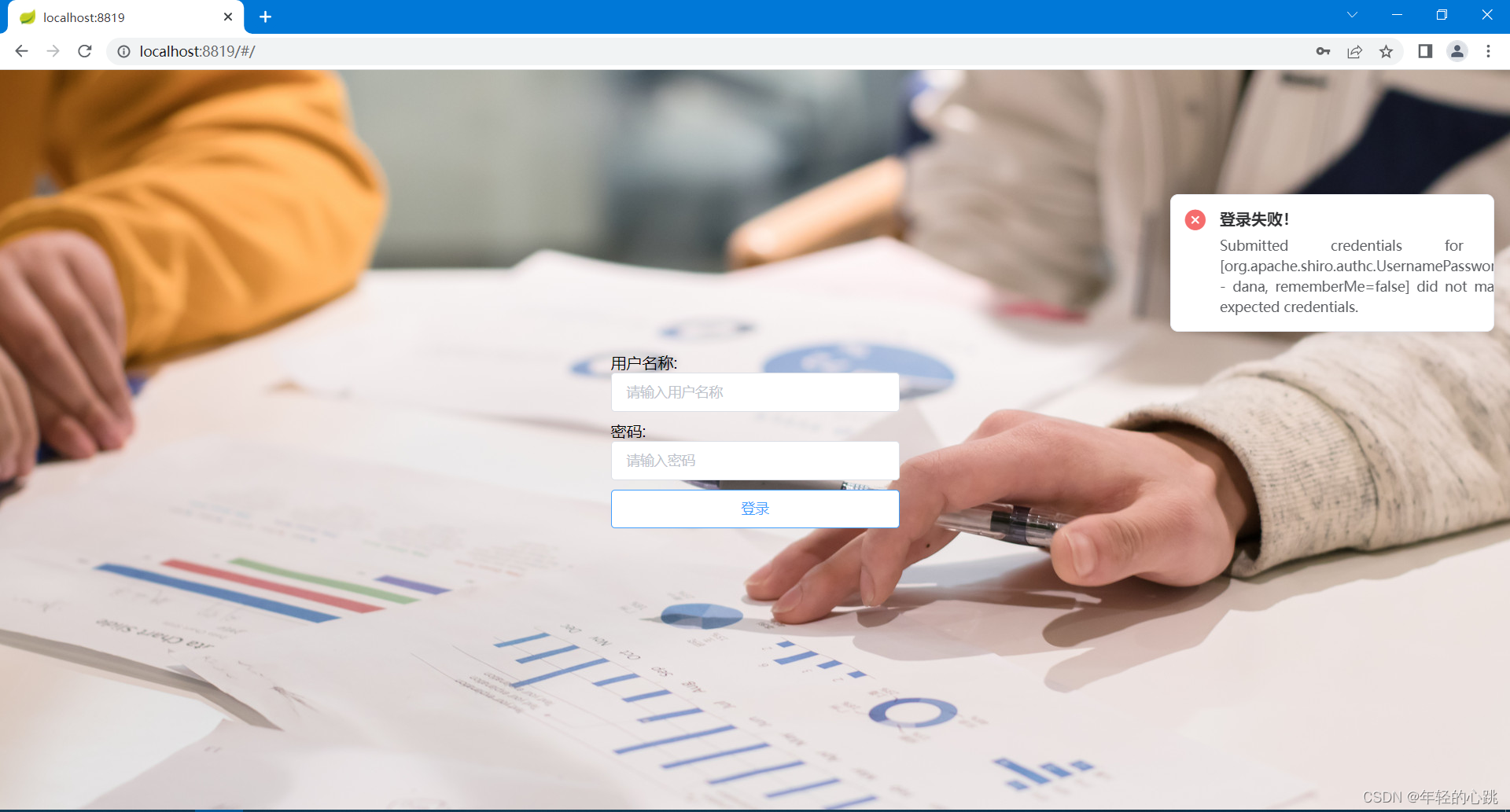
9、src/main/resources/static/index.html
queryPermissionList() {
axios.defaults.headers.token = this.token;
axios.defaults.headers.post['Content-Type'] = 'application/json;charset=UTF-8';
axios({
method: 'post',
url: '/user/findPermissionListByRoleId',
data: JSON.stringify({
id: 0
})
}).then(response => {
if(typeof response.data.error !== 'undefined' || response.data.error != null){
ELEMENT.Notification.error({
title: '查询失败!',
message: response.data.error,
position: 'top-right',
showClose: false,
offset: 110
});
return;
}
this.permissionData = response.data.allPermissionList;
}).catch(error => {
console.log(error);
ELEMENT.Message(error);
});
},
10、com/example/demo/config/UserSessionManager.java
package com.example.demo.config;
import org.apache.shiro.web.servlet.ShiroHttpServletRequest;
import org.apache.shiro.web.session.mgt.DefaultWebSessionManager;
import org.apache.shiro.web.util.WebUtils;
import javax.servlet.ServletRequest;
import javax.servlet.ServletResponse;
import java.io.Serializable;
public class UserSessionManager extends DefaultWebSessionManager {
public static final String AUTHORIZATION="token";
public UserSessionManager() {
super();
}
@Override
protected Serializable getSessionId(ServletRequest request, ServletResponse response) {
//获取sessionId
String sessionId= WebUtils.toHttp(request).getHeader(AUTHORIZATION);
if (sessionId!=null && sessionId!=""){
request.setAttribute(ShiroHttpServletRequest.REFERENCED_SESSION_ID_SOURCE,
ShiroHttpServletRequest.COOKIE_SESSION_ID_SOURCE);
request.setAttribute(ShiroHttpServletRequest.REFERENCED_SESSION_ID, sessionId);
request.setAttribute(ShiroHttpServletRequest.REFERENCED_SESSION_ID_IS_VALID, Boolean.TRUE);
return sessionId;
}else {
return super.getSessionId(request,response);
}
}
}
11、参考链接:
https://blog.csdn.net/qq_25046827/article/details/124540457
https://blog.csdn.net/palerock/article/details/73457415
前端控制按钮显隐,后端请求路径拦截配置
用户登陆成功后会返回用户具有的权限列表,根据权限列表控制前端控制按钮显隐及后端请求拦截路径,
总结如下:
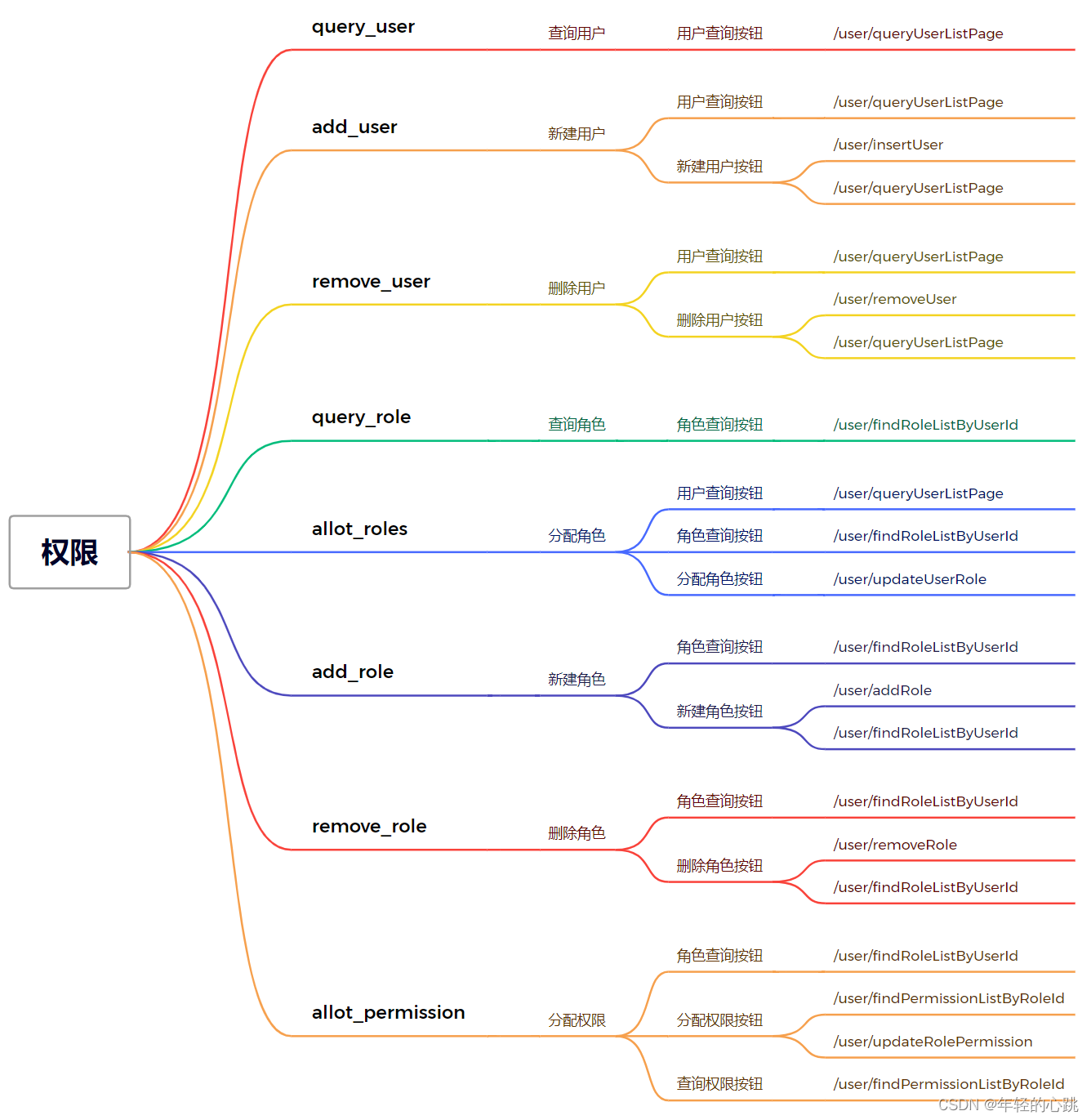
相关代码
com/example/demo/config/ShiroConfig.java
package com.example.demo.config;
import org.apache.shiro.authc.credential.HashedCredentialsMatcher;
import org.apache.shiro.mgt.SecurityManager;
import org.apache.shiro.session.mgt.SessionManager;
import org.apache.shiro.spring.web.ShiroFilterFactoryBean;
import org.apache.shiro.web.mgt.DefaultWebSecurityManager;
import org.apache.shiro.web.session.mgt.DefaultWebSessionManager;
import org.springframework.context.annotation.Bean;
import org.springframework.context.annotation.Configuration;
import java.util.LinkedHashMap;
import java.util.Map;
@Configuration
public class ShiroConfig {
@Bean
public ShiroFilterFactoryBean shiroFilter(SecurityManager securityManager) {
System.out.println("ShiroConfig ShiroFilterFactoryBean 执行");
ShiroFilterFactoryBean shiroFilterFactoryBean = new ShiroFilterFactoryBean();
//设置SecurityManager
shiroFilterFactoryBean.setSecurityManager(securityManager);
//如果访问需要登录的某个接口,却没有登录,则调用此接口(如果不是前后端分离,则跳转页面)
//shiroFilterFactoryBean.setLoginUrl("/index.html");
//登录成功后,跳转的链接,若前后端分离,没必要设置这个
//shiroFilterFactoryBean.setSuccessUrl("");
//登录成功,未授权会调用此方法
//shiroFilterFactoryBean.setUnauthorizedUrl("/user/*");
//拦截路径,必须使用:LinkedHashMap,要不然拦截效果会时有时无,因为使用的是无序的Map
Map<String, String> filterChainDefinitionMap = new LinkedHashMap<>();
//key=正则表达式路径,value=org.apache.shiro.web.filter.mgt.DefaultFilter
//退出过滤器
//filterChainDefinitionMap.put("/logout", "logout");
//匿名可以访问,游客模式
filterChainDefinitionMap.put("/", "anon");
filterChainDefinitionMap.put("/user/login", "anon");
//登录用户才可以访问
filterChainDefinitionMap.put("/user/**", "authc");
//管理员角色才能访问
//filterChainDefinitionMap.put("/user/**", "roles[admin]");
//有权限才能访问
filterChainDefinitionMap.put("/user/queryUserListPage", "perms[query_user, add_user, allot_roles, remove_user]");
filterChainDefinitionMap.put("/user/insertUser", "perms[add_user]");
filterChainDefinitionMap.put("/user/removeUser", "perms[remove_user]");
filterChainDefinitionMap.put("/user/findRoleListByUserId", "perms[allot_roles, query_role, add_role, remove_role, allot_permission]");
filterChainDefinitionMap.put("/user/updateUserRole", "perms[allot_roles]");
filterChainDefinitionMap.put("/user/addRole", "perms[add_role]");
filterChainDefinitionMap.put("/user/removeRole", "perms[remove_role]");
filterChainDefinitionMap.put("/user/findPermissionListByRoleId", "perms[allot_permission]");
filterChainDefinitionMap.put("/user/updateRolePermission", "perms[allot_permission]");
//authc:url必须通过认证才可以访问
//anon:url可以匿名访问
//过滤链是顺序执行,从上而下,一般把/**,放到最下面
filterChainDefinitionMap.put("/**", "authc");
shiroFilterFactoryBean.setFilterChainDefinitionMap(filterChainDefinitionMap);
return shiroFilterFactoryBean;
}
@Bean
public SecurityManager securityManager() {
DefaultWebSecurityManager securityManager = new DefaultWebSecurityManager();
//如果不是前后端分离,不用设置setSessionManager
securityManager.setSessionManager(sessionManager());
securityManager.setRealm(userRealm());
return securityManager;
}
/**
* 自定义realm
*
* @return
*/
@Bean
public UserRealm userRealm() {
UserRealm userRealm = new UserRealm();
//因为数据库密码存的是明文,所以无需使用双重md5校验
// customRealm.setCredentialsMatcher(hashedCredentialsMatcher());
return userRealm;
}
/**
* 密码验证器,双重md5
*
* @return
*/
@Bean
public HashedCredentialsMatcher hashedCredentialsMatcher() {
HashedCredentialsMatcher hashedCredentialsMatcher = new HashedCredentialsMatcher();
//设置散列算法,使用md5算法
hashedCredentialsMatcher.setHashAlgorithmName("md5");
//散列次数,使用2次md5算法,相当于md5(md5(xxx))
hashedCredentialsMatcher.setHashIterations(2);
return hashedCredentialsMatcher;
}
/**
* 自定义SessionManager
*
* @return
*/
@Bean
public SessionManager sessionManager() {
UserSessionManager userSessionManager = new UserSessionManager();
//超时时间,默认 30分钟,会话超时,单位毫秒
// customSessionManager.setGlobalSessionTimeout(200000);
return userSessionManager;
}
}
待完成
1、密码加解密;
2、记住我;


